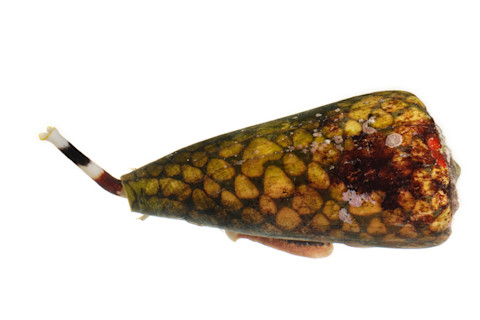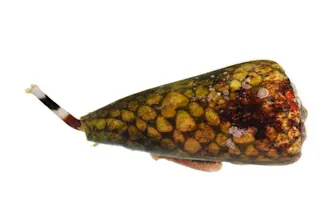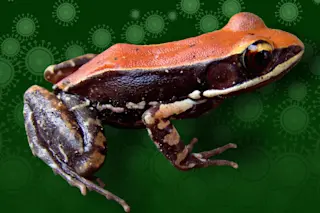Biochemist Glenn King spends his days getting up close and personal with the creatures that make us shudder: spiders, centipedes and scorpions. He’s collecting their often-deadly venoms to find the perfect painkiller.
King, a researcher at the University of Queensland in Australia, studies the neurotoxins that allow these creatures to paralyze and kill their prey. The toxins shut down a channel on the membranes of different types of neurons. In humans, the same mechanism that spells doom for prey could be modified to stop pain signals in their tracks. As King explains it, this channel is the first step in the process of amplifying pain signals up the spinal cord to the brain. If researchers can use venoms to develop a drug that blocks this channel, we could provide relief for chronic pain sufferers and possibly shake our dependence on opioid-based painkillers, such as oxycodone or hydrocodone.
Derived from the opium poppy, opioids alleviate pain by binding to opioid receptors in the brain. They’ve been around for thousands of years in one form or another, both as recreational drugs and as painkillers, like morphine or codeine. Along with pain relief, opioids offer euphoria, but they also pose a risk of addiction and drug tolerance.
“It’s not simply that they’re really addictive, which makes putting someone with chronic pain on an opioid a bad idea. It’s also a bad idea because when you take an opioid on a regular basis, they can become ineffective,” says Andrew Kolodny, director of Physicians for Responsible Opioid Prescribing, a national advocacy group.
Since the resurgence of opioid-based medications to treat pain in the 1990s, the drugs have become the primary source of fatal overdoses in the United States. Seventy-one percent of the 22,767 deaths related to pharmaceutical overdose in 2013 involved prescription opioid pain relievers, according to the Centers for Disease Control and Prevention.
Animal toxins can alleviate chronic pain without inducing tolerance or addiction because they target parts of the nervous system outside the brain. It seems counterintuitive that something meant to kill or paralyze could ultimately save lives, but by studying different toxins produced by animals, scientists are gaining greater insight into how pain works in the first place. In fact, one of the first clues to understanding how pain signals make it to the brain came from an unusual source: snails. But we’re getting ahead of ourselves. First, let’s look at just how we feel pain.
Pain Amplifier
A pain signal is just your body’s way of alerting you to damage in your cells. Cells respond to a threat by leaking a small sodium-ion charge through a pore in the cell membrane called voltage-gated sodium channel 1.7, or Nav 1.7. In effect, this sodium channel amplifies the pain signal so it can be “heard” by the brain, says King.
Researchers confirmed the effects of this channel a decade ago when a doctor from the United Kingdom visited Pakistan. The doctor heard about a street show where a young man could stab himself in the arm without pain, getting patched up later in a hospital. Intrigued, the doctor, a geneticist named Geoffrey Woods, eventually discovered two families who carried a genetic mutation that blocked the functioning of sodium channel 1.7. He found a mutation that kept people pain-free.
Aside from a diminished sense of smell, people with the mutation were otherwise healthy. Woods published his findings in 2006 in the journal Nature, suggesting that this discovery could “stimulate the search for novel analgesics that selectively target this sodium channel.”
And that’s just what researchers and pharmaceutical companies are racing to do. They want to find something — an engineered small molecule, antibody or, in King’s case, a peptide isolated from venom — that inhibits the functioning of sodium channel 1.7. But there are nine similar sodium channels responsible for a variety of functions in the body. For instance, sodium channel 1.5 is the heart sodium channel. If your 1.7-blocking painkiller also blocks 1.5, the patient would die of heart failure, says King.
Most drugs on the market today are small molecules, active organic compounds with a structure and weight so minute that they can be ingested and pass more easily through cell membranes. Many small-molecule drugs work by blocking the pore of a channel, but there’s a problem: The pores of all nine sodium channels are similarly shaped.
King believes that venom-based peptides — short chains of amino acids — are better at being selective than small molecules because the venom peptides don’t target the pore; they target a specific sodium channel switch. When researchers talk about channel selectivity, they’re referring to the ability of peptides or small molecules to turn off only one particular sodium channel.
“Without [sodium channel] 1.7, the pain signals simply don’t get amplified to a level where it gets the signal up to the spinal cord and up to the brain,” so the brain never knows about it, he says.
Spiders, Centipedes and Scorpions
Not just any venomous creature will do to create sodium channel blockers. “The animals that we’re solely focused on are those that have neurotoxin venoms,” says King.
Snake and reptile venoms typically don’t work for this type of research because most of them function as hemotoxins (which destroy red blood cells) and target components of the cardiovascular system, King says. “You want animals that make molecules that modulate the nervous system.”
To that end, King has collected samples of venom from all over the world, mostly from spiders. “Spiders have proved to be the best so far,” says King, who has screened 300 different arachnid venoms. The more diverse his venom collection, the more likely he can find a useful — and selective — peptide.

Harvesting venom is easier when working with large spiders, which secrete the toxin — then collected noninvasively with a pipette — in sufficient amounts for researchers to analyze and test. | Glenn King/Institute for Molecular Bioscience/University of Queensland
Another reason why he works primarily with spiders is that despite their reputation, spiders are not as dangerous to humans. “Even the very biggest tarantula — as big as a dinner plate — can’t kill you,” says King.
For King’s purposes, bigger spiders have another advantage: Their size makes it easier to get sufficient venom to test, compared with smaller species.
Spiders don’t have a monopoly on promising peptides, though. For millennia, the Chinese have made use of the medicinal properties of scorpion venom for chronic pain and a host of other ailments. Recent research shows that scorpion venom, too, can be a potent sodium channel blocker. King has also found a potential 1.7 blocker in centipedes. In a recent paper published in Proceedings of the National Academy of Sciences, King detailed how, in mouse models, a peptide from the venom of the Chinese red-headed centipede acted as a more potent painkiller than morphine — without side effects.
King acquired enough of that centipede for limited testing, but getting sufficient amounts of venom from other species of centipede has proven to be a challenge. “We’re trying to understand how to engineer the venom peptides so they can be even more selective, but to accumulate enough venom to do a screening is very difficult,” he says.
The Cone Snails
While growing up in the Philippines, biochemist Baldomero Olivera collected the shells of cone snails — small, tropical marine snails whose harpoonlike hook snags and paralyzes fish. Years later, he decided to investigate the chemical components of the snail toxins, which, in rare cases, can cause human fatalities.
In the late 1970s, while at the University of Utah, Olivera’s students Craig Clark and Michael McIntosh tried injecting the cone snail venom directly into the brains of mice and discovered that different components of venom changed the animals’ behavior. Some made them sleep, jump or even scratch.

Cone snails use a venomous, harpoonlike hook to snag and paralyze small fish. | Darlyne A. Murawski/National Geographic Creative
Further research determined that certain components of the cone snail venom, called conotoxins, targeted voltage-gated calcium channels, which, like sodium channels, handle communication between pain-sensing neurons and the brain. The colorful snails yielded the first hint that these calcium channels could make a potent target for pain relief. By 2004, the drug companies Neurex and Elan had developed an alternative to morphine called Prialt, or ziconotide, which makes use of this toxin. The downside: The drug has dose-limiting side effects and can be applied only through injection into the spinal cord, making it less practical as a mainstream painkiller.
Olivera is still exploring the chemical cocktail available in conotoxins. What makes cone snail venom a uniquely useful treasure-trove of potential pharmaceuticals is the nature of the snails’ attack.
To capture prey, predators use mechanical or chemical methods. For instance, a snake has venom, but it also can make use of its speed and jaws to catch prey. Cone snails are tiny creatures without much weaponry to kill besides their venom. “They’re totally dependent on having a really potent chemical strategy,” says Olivera.
The cone snails have evolved a particularly effective venom, notes chemist David Craik. Their venom peptides hit a wide variety of pain targets, including sodium channels, calcium channels and other receptors.
“Mother Nature has been a wonderful, productive source of drugs”
The challenge of using peptides as drugs is that they’re not viable in pill form because our digestive system breaks them down. That’s a reason why ziconotide must be injected directly into the spine. But Craik, a researcher at the University of Queensland, is creating drugs based on cone snail toxins that could be taken orally. He’s studying a type of plant peptide with a looped structure of amino acids. The loop shape allows the peptide to be more stable — and possibly survive a trip through the digestive tract.
Craik’s idea is to combine this type of amino acid structure with a conotoxin, designing a more user-friendly medication, perhaps in pill form. The type of conotoxin molecule he’s studying binds to a receptor called GABA B, inhibiting transmission of nerve impulses. Because GABA B is in a different class from opioid receptors, potential side effects in such a drug would be limited.
Conotoxin doesn’t act in the central nervous system, which is where you’d worry about serious side effects, says Craik. Instead, it operates in the peripheral nervous system, outside the brain and spinal cord. “It’s a different mechanism of action,” says Craik, who has tested the new drug in animals and hopes to begin human trials within two years.
Under the Sea
Biochemist George Miljanich — one of the creators of Prialt, the painkiller based on a cone snail toxin — is now seeking a sodium channel blocker from an even more surprising source: saxitoxin, made by bacteria found in the algae that can cause toxic red tides.

Red Tide algal blooms are caused by high concentrations of microscopic plankton. | Bill Bachman/Science Source
Compounds like saxitoxin cause paralytic shellfish poisoning in humans, he says, but these toxins also bind to six out of the nine sodium-channel subtypes. “Our challenge, building on what Mother Nature has given us, is to narrow that selectivity down from the six down to the one, Nav 1.7,” says Miljanich.
Unlike the peptides derived from spider or centipede venoms, saxitoxin is a small molecule, which means any medication based on it can be taken as a pill.
Miljanich believes that a viable alternative to opioids that could work against all pain syndromes could arrive in the next three to four years, most likely as some sort of sodium channel 1.7 blocker. But developing new analgesics is a real challenge. Prialt, he says, was arguably the only new non-opioid analgesic approved by the FDA in the past 20 years.
It’s challenging to find alternatives to opioids because it’s so difficult to craft painkillers without side effects. For instance, the skin toxins of poison-dart frogs drew attention 20 years ago as a potential painkiller that worked by targeting nicotine receptors. But an effective dose turned out to include toxic side effects.
Researchers working on venom-based painkillers are undeterred. “Mother Nature has been a wonderful, productive source of drugs,” says Miljanich.
And even if engineered components of venom don’t become drugs themselves, they have been useful in pointing out potential new targets, says Olivera, who collaborated with Miljanich in research into conotoxins.
What makes Olivera optimistic in the long run is that venoms offer a tool kit for understanding what happens when you have severe pain. “Basic understanding of what causes pain in the first place is the key to coming up with ways to prevent it,” he says.
["This article originally appeared in print as "This Won't Hurt."]







